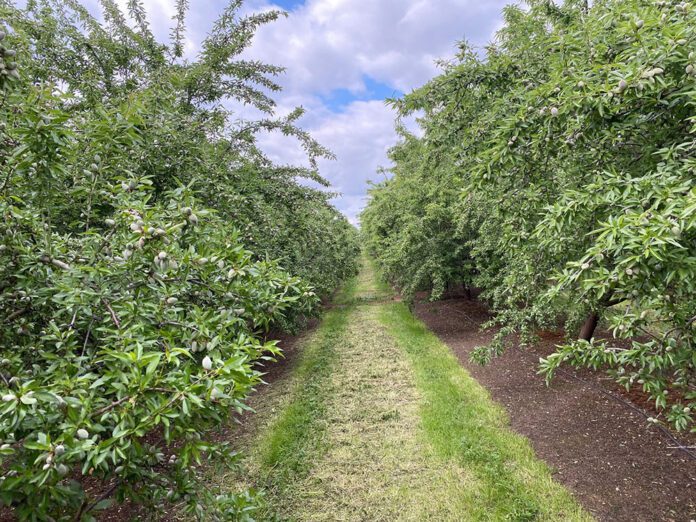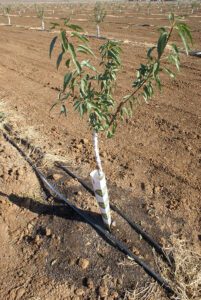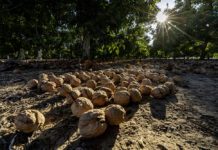
One size does not fit all, particularly when it comes to nutrition in young tree nut orchards.
At a young orchard irrigation and nutrition management workshop hosted by UCCE Kern County, speakers detailed research and observations about tailoring nutrition deliveries to meet demands of newly planted and nonbearing almond, pistachio and walnut trees.
Applied nutrients are needed to support growth of trunks, roots, branches and leaves in the first year after planting in most cases. Cultivar, rootstock, climate and irrigation determine a tree’s potential for growth. Nutritional deficiencies in the early stages will lead to smaller, stunted trees with weaker growth.
Conversely, overapplication of fertilizer in excess of tree demand will promote lanky growth, loss of nutrients below the root zone and add higher input costs.
Accurate Accounting
Ben Halleck, a senior research assistant at Fresno UCCE, said effective nutrient management requires accurate accounting for crop and growth demand. When planning nutrition budgets, orchards should be assessed for previous year’s performance, previous season’s tissue analysis and overall canopy conditions.
Young, nonbearing trees need three macronutrients: nitrogen, phosphorus and potassium. Micronutrients are also essential for plant growth, and a deficiency in any micronutrient has the potential to cause a decrease in tree health and, later, crop quality and yield.
Halleck said nutrient management in young orchards requires understanding of tree requirements, uptake patterns, nutrient budgeting and soil and tissue analysis. Irrigation management to deliver nutrients to the trees is also essential.
Trees store nutrients in canopy branches, trunks and roots during dormancy and redistribute them during growth in the spring. Uptake of nutrients only occurs during active growth beginning at leaf-out. Highest uptake time is from onset of shoot growth to late stages of nut development.
Factors that influence nutrient availability to trees include soil texture and mineral composition, nutrient interactions, soil organic matter, soil pH, water quality and the fertilizer form and application method. Halleck said foliar applications can be used to overcome soil chemical or physical conditions that prevent uptake.
Distribution uniformity and irrigation efficiency also contribute to nutrient use efficiency. Flushing nutrients down below the root zone or uneven distribution is a waste of expensive orchard inputs.
That is why, Halleck said, frequent, small doses of nutrients are best for young trees. Concentrations of nutrients above adequate levels do not increase uptake.
Cameron Zuber, UCCE orchard crops advisor in Merced County, said the N baseline for new almond orchards is 30 pounds per acre. If second leaf trees bear a crop, that amount goes up to 55 pounds. By third leaf, 65 pounds per acre is recommended, or 68 per 1,000 pounds of kernels harvested.
When applying N to single trees, he warned, not more than one ounce per tree for any single application.
Almond Board of California notes that research shows trees planted after whole orchard recycling may require higher amounts of N in the first year. To ensure N is delivered appropriately, growers should look to hand delivery.
“Nitrogen is nitrogen,” Zuber said. Almond trees can use different fertilizer and organic N sources to meet their N demand. Those include ammonium nitrate, calcium ammonium nitrate, potassium nitrate and ammonium sulfate.
Irrigation water may contribute to the N budget for trees. Adding organic matter to the soil also provides N, but the rate at which it becomes plant-available varies depending on the carbon to nitrogen ratio.
In most California soils, N is the only required fertilizer for newly planted trees. It can be reduced or omitted the first two seasons on fertile soils. If N application is warranted. Moneim Mohamad, UCCE irrigation and soils advisor in Stanislaus County, said it is recommended to use granular fertilizer as the liquid form may burn roots. Applications are done in mid-spring and early summer. K may be required for K-fixing soils.

Young Pistachio and Walnut Trees
Phoebe Gordon, UCCE orchard crops advisor in Madera County, said it is critical to understand that just because a plant function is impaired by nutrient deficiency does not mean the function will be enhanced by overapplication of that nutrient. The nutrients to be concerned about in young pistachios are nitrogen, zinc, copper and possibly phosphorus.
Leaf sampling can be done to determine deficiencies. Samples are done in July, pulling subterminal leaflets from several leaves around each sampled tree. All four quadrants of the tree should be sampled, and samples pulled from at least five feet off the ground. Samples should be mixed, bagged and sent to a testing laboratory.
First-leaf pistachio trees may need very little N, Gordon said. Her suggested rates are not based on research but results from two field trials at the West Side Research Center. Pre-budded trees there received 1.33 ounces N while first-leaf trees received 2 ounces N. Fertilizer should be hand-applied at the tree base and drip emitters placed in the root zone.
Pistachio growers should also be aware of winter juvenile tree dieback in young trees, Gordon said. This condition is associated with rootstocks that have P Integerrima, PG1 or UCE 1 seedling or clonal. Affected trees are high vigor going into fall, usually, but not always associated with frost events. She suggested N applications be cut off for juvenile trees by July and irrigation cut off in late summer or early fall depending on soil type. The goal is to have growth stop before the first frost.
The micronutrient zinc is immobile in pistachios, including foliar-applied zinc. To be most effective, Gordon said, it should be applied during early spring flush as absorption decreases rapidly as leaves age.
Copper deficiencies in pistachios are not uncommon, Gordon said, and are found in young orchards on the east side of the valley. Symptoms are tiny, undeveloped leaves at leaf terminals. Gordon said foliar applications are effective. The solution is 0.33 to 0.5 pounds CuEDTA to 100 gallons of water.
First-leaf walnut trees may not need any other nutrients besides N and even that input can be reduced the first two growing seasons on fertile soils. K may be needed when soils are low in K. The fertilizer can be banded or fertigated.
Mohamad said if N fertilization is needed, it should be done in mid spring or early summer in dry form or fertigation. He cautioned that during the first year, roots can be burned with N fertigation.
The 4 Rs of fertilizer management is the best strategy for young walnuts, he noted.
Resources
Online tools that can assist with nutrition budgeting include CropManage: https://cropmanage.ucanr.edu
CDFA FREP website for orchard crops: www.cdfa.ca.gov/is/ffldrs/frep/fertilizationGuidelines
UC Davis Fruits and Nuts website: https://fruitsandnuts.ucdavis.edu.

Cecilia Parsons | Associate Editor
Cecilia Parsons has lived in the Central Valley community of Ducor since 1976, covering agriculture for numerous agricultural publications over the years. She has found and nurtured many wonderful and helpful contacts in the ag community, including the UCCE advisors, allowing for news coverage that focuses on the basics of food production.
She is always on the search for new ag topics that can help growers and processors in the San Joaquin Valley improve their bottom line.
In her free time, Cecilia rides her horse, Holly in ranch versatility shows and raises registered Shetland sheep which she exhibits at county and state fairs during the summer.















